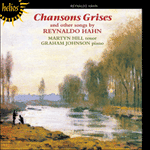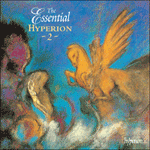
Welcome to Hyperion Records, an independent British classical label devoted to presenting high-quality recordings of music of all styles and from all periods from the twelfth century to the twenty-first.
Hyperion offers both CDs, and downloads in a number of formats. The site is also available in several languages.
Please use the dropdown buttons to set your preferred options, or use the checkbox to accept the defaults.

The Études Latines is a group of eighteen poems, ten of which Hahn chose to set for his cycle. He begins with Lydie—the poem with which Leconte de Lisle opens his set—but after that rearranges the order at will. As an act of piety he excluded the poem Lydia which Fauré had set once and for all as early as 1871. But it is the Attic tone of that masterpiece—sparing of notes, pure in spirit—which Reynaldo wished to emulate. This is pastiche of quite a different kind to À Chloris for example. At least we know what seventeenth-century music sounded like. The music of the ancients has remained a much more mysterious proposition and gives the composer a free hand in imagining a world of musical calm where modes replace scales and shepherd pipes replace the piano. This type of evocation has very much a fin de siècle feel to it (as does the Debussy cycle about the Greek girl Bilitis, for example) and a host of images of a fey and fake antiquity come to mind: the classical paintings of Alma-Tadema, countless early photographs of young girls and comely youths posed in white tunics, the barefoot dancing of Isadora Duncan and so on. For the purposes of this ‘revival’ the words ‘Greek’ and ‘Roman’ seem fairly interchangeable and there is no sign that composers differentiated between the two (very different) cultures when transporting us to a sort of all-purpose antiquity. There is no doubt that the re-exploration of the ancient world was fashionable among the aesthetes; homosexual love between man and boy, misunderstood and persecuted in modern times, was thought of as an accepted fact of everyday life in distant centuries (we now know this to be an oversimplification of the historical facts). The ideals of classical purity were thus tinged with a delicious decadence. (For Pierre Louÿs, the author of Chansons de Bilitis, it was an epoch inhabited by teenage nymphs in the briefest of chitons, and no less delicious.) Reynaldo finished the composition of this cycle during a visit to Rome in 1900.
Hahn employs a chorus in three of these songs (numbers I, IV and IX). The opening chorus with tenor solo entitled Lydie has the energy of youthful games; perhaps Hahn has the famous Degas painting of ‘The Young Spartans’ in mind, the girls facing the boys and sexual tension in the air. The piano ostinati propel the vocal line without adding much to the musical argument. Indeed, throughout this cycle the piano’s contribution is kept to a minimum as if to keep an obvious anachronism in the background.
Both Néère and Lydé are beautiful songs in the manner of late Fauré (Dans la Nymphée and Diane, Séléné come to mind). Crotchets in the piano, almost monotonous, change the harmonies discreetly while the vocal line weaves its spell in quavers. The first of these songs is hypnotically gentle and personal, the second is grander and more in the manner of an oration or religious ceremony.
Salinum is a free recitative accompanied by flute; this is Hahn at his most minimalist. Thaliarque, the least Fauréan of the cycle’s songs is nevertheless dedicated to that master. It is a duet between two choruses—‘Jeunes filles’ and ‘Jeunes hommes’. A flowing tune is rendered slightly more piquant by a hemiola in the accompaniment which sets up a rhythmic conflict between voices and piano.
Vile potabis is a drinking song with a heart, a gentle and unexceptional fragment.
The jewel of the cycle is undoubtedly Tyndaris. It is here that Hahn finds the perfect pasticheur’s voice to evoke this dream of distant antiquity. The limpidity of the quasi-modal accompaniment (who else would make something so beautiful of a simple downward scale at the song’s opening?) and the unforced prosody of a vocal line which seems to flow from the heart combine to ravishing effect. Here is a song as fresh and unspoiled as Hahn imagined the civilisation which inspired it to be. Distance has truly lent enchantment. Pholoé has a grave beauty of its own. Less winning than Tyndaris, it has a measured grace and sacerdotal manner which is at one with the sacred mood planned by Hahn for some of these pieces. After this essay in the aeolian mode the composer allows himself the mischievous luxury of a tierce de picardie at the final cadence. Phidylé—quite a different poem from that set by Duparc—is the song in the cycle which calls for the largest forces: six sopranos, four tenors, a solo bass, and piano duet accompaniment. The steady progress of unexceptional dotted quavers in the accompaniment is the background to a depiction of a religious ceremony. The beautiful Phidylé makes the offering under the watchful eye of the officiating priest. The dedication reads ‘À mon ami Marcel Proust’. The final song of the set, Phyllis, was chosen as such by the composer because of the final words: ‘Ô belle fin de mes amours.’ This suggests that the protagonist, after a life of many lovers, has at last found his ideal. The song is headed ‘serieux et tendre’ and the music lives up to this marking. The opening refrain in a lilting 9/8 binds the song together in the best Hahnian manner, its repetitive nature making the point of undying love. The poems of Leconte de Lisle can sometimes be impossibly grand and marmoreal. Sometimes they defeat Hahn and the result seems affected and cold, but here the flexibility of the vocal line and Reynaldo’s empathy with the words warm the images into life.
from notes by Graham Johnson © 1996
 Hahn: Chansons grises & other songs Hahn: Chansons grises & other songs‘Beautifully performed’ (Gramophone) ‘Martyn Hill’s tenor is perfectly suited to Hahn’s deliciously sentimental idiom … most of the settings on the disc are to texts by his favourite ...» More |
 The Essential Hyperion, Vol. 2 The Essential Hyperion, Vol. 2'More than just a highlight sampler. This is a classy collection, brought together with a great deal of care and attention to musical programming seldom found in this kind of CD … A stocking-filler any music lover would appreciate' (Scotland ...» More |

